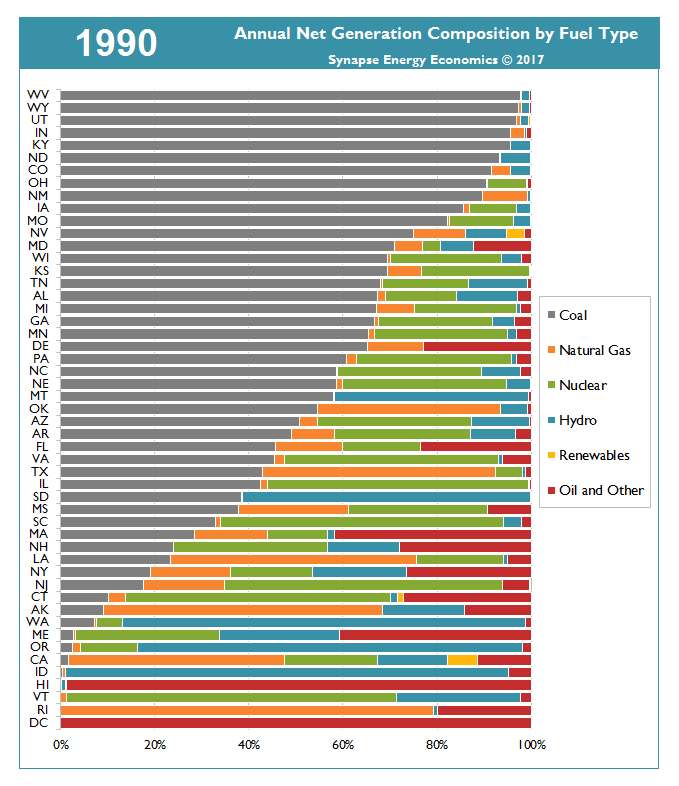The last big coal plant in New England is gone, New Jersey’s biggest utility is done with coal generation, and Florida’s largest electric utility is retiring yet another coal plant. These are more solid signposts on the way to our clean energy future… if we get this right. But as coal exits, what’s taking its place?
Exit Big Coal
A spate of recent energy headlines make clear that, despite President Trump’s stunning abdication of climate and energy leadership, coal is on its way out. Take these, for example:
- New England’s largest coal plant just shut down for good. When the plant’s owners announced their decision to retire the Brayton Point power plant in Massachusetts, it was clear that there were a lot of reasons to celebrate, and those still hold. Meanwhile, the three remaining coal plants in the region look to be on their way out, too.
- PSEG just retired its last two coal plants in New Jersey, the state’s largest.
- Meanwhile, Florida Power & Light, along with Jacksonville’s municipal utility, have just asked for permission to shut down the St. Johns River Power Park coal plant that they jointly own. For FP&L, that’s just one more step in its move away from coal.
Clean energy has been a part of this energy transformation. The biggest factor in coal’s demise, though, say the utilities involved, has been the severely eroded economics of coal versus natural gas. “The way the market works, the economics don’t work [for coal],” says PSEG. In Florida, FP&L says that shutting the St. Johns plant is part of a plan to “save customers millions of dollars on fuel costs” while cutting air pollution.
That’s worth underscoring: By retiring coal, utilities aren’t just reducing public health risks; they’re also saving money. Not the story that coal-is-cheap boosters would have you believe.
Another splash of this new reality, actually, comes from the director of President Trump’s National Economic Council himself. “Coal doesn’t even make that much sense anymore,” says Gary Cohn, citing natural gas, wind, and solar as better options.
Enter… who?
With coal on its way out, though, what’s replacing it? That’s where a new graphic about the evolution of electricity mixes is really handy.
The graphic, from Pat Knight at Synapse Energy Economics, is an updating of one of his that I talked about a couple of years ago, and the latest version is just as mesmerizing (and, with a slower rate, even easier to follow). Here’s the GIF version, which covers 1990 to 2016:

And below are stills of two of the years, showing that even the transformation over just the last decade is a marvel to behold:
While the growth in natural gas (orange bars) is worthy of caution—maybe an elephant-sized amount of caution at that—lots of positive things jump out from the GIF and those juxtaposed years, stuff like:
- The dark upper left corner (coal) is shrinking, consistent with the straight-from-the-headlines tidbits above. Look at Nevada, Delaware, and Oklahoma. Pennsylvania and Virginia. Alabama. Even Utah, Indiana, and New Mexico. And that progress may just be a down payment on going coal free.
- Even at the low end of coal usage, Synapse’s Pat Knight notes that the number of states producing 10% or less of their electricity from coal has almost doubled in recent years, going from nine in 2007 to 17 in 2016.
- As the GIF version shows, while it once played a big role in electricity generation, oil is basically gone from the power sector, with the exception of Hawaii and Alaska. (In Knight’s version, the “other” in those red bars includes biomass, which is why Maine and Vermont show up redder than they otherwise might.)
- And then there are those yellow bars, the non-hydro renewables piece that barely existed in 2006, and are now forces to be reckoned with. Knight notes that the number of states producing 10% or more (much more, in some cases) of their electricity from renewables other than hydro grew from 0 in 2007 to 17 in 2016. We have wind power to thank for that in various states—Iowa, South Dakota, Kansas, Oklahoma, and North Dakota each generated at least 20% from wind last year—and solar is coming on strong.
Even if President Trump is unwilling or unable to move ahead on energy, plenty of others get it. Forward-thinking utilities are continuing to embrace evolution—even revolution—in the energy sector. So are states leading on clean energy momentum.
Our changing electricity mixes and the latest news make clear that coal is on its way out. Now we just need to be smart about what replaces it.

